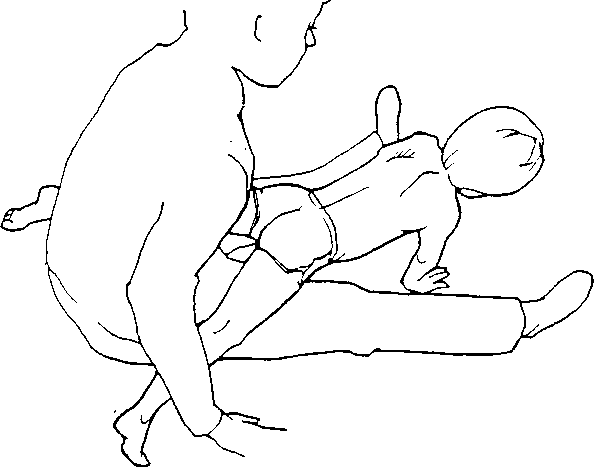
26 HOME INSTRUCTIONS
Squatting
Purpose
To encourage child to maintain a squatting position
Instructions
1. Kneel behind child. Place child in a squatting position; feet should be flat on floor.
2. Stabilize child's body by placing your hands on knees as pictured below. Support only as much as needed.
3. Keep the child's weight forward on the feet.
4. Allow child to play in this position.
Desired Response
Child will be able to maintain this posture for several minutes at a time.
Undesired Response
Legs will pull apart or head and trunk will "flop" forward.

27 HOME INSTRUCTIONS
Stretching for Torticollus
Purpose
To stretch a tight muscle that is not allowing infant to move head properly
Instructions
1. Place infant on back.
2. Place right hand on top of Infant's right shoulder and left hand under left side ounfant's head. (Or, place left hand on top of infant's left shoulder and right hand under right side of infant's head) .
3. While holding shoulder down, move head toward opposite shoulder.
4. When you feel tightness, move a little further. Then, stop and hold for a count of five.
5. Release your pressure. Repeat five times.
When to do Exercises
Immediately following infant's bath and three more times spread throughout the day.
Desired Response
The tight muscle should gradually loosen so the head can be moved without any resistance.

28 HOME INSTRUCTIONS
Thumb Abduction
Purpose
To encourage the child to hold hand open with the thumb away from the palm
Instructions
1. Gently but firmly apply pressure to trvS base of the thumb. '
2. Bring the base of the thumb away from the palm. Note: Do not pull the thumb as this may be harmful.
3. Hold the thumb in this position while child plays.
Desired Response
Slowly the child will begin to hold the thumb away from the palm.
Undesired Response

The end of the thumb will come away from the palm but the base of the thumb will remain tight.
29 HOME INSTRUCTIONS
Purpose
To relax muscle tone in trunk
Instructions
1. Place child on back, holding legs with your hands.
2. Curl child up into a "ball" so seat is up in the air (see Figure 1).
3. Slowly roll hips and legs to side (oee Figure 2).
4. Repeat in opposite direction (see Figure 3).
Desired Response
Trunk will relax .,
Undesired Response
Trunk will become stiff.
NOTE: Do not force. As child becomes more relaxed, you may be able to move further.
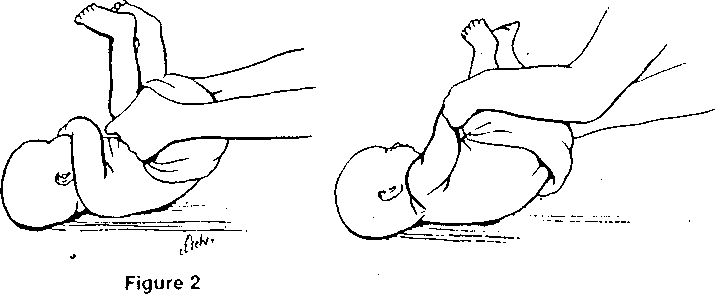

30 HOME INSTRUCTIONS
To encourage child to play with hands in midline and to bring hands to mouth
Instructions
Place child on side as pictured below. Arms should be forward, and hips and knees should be bent. Head should be bent and may be supported for comfort. If necessary, assist child in bringing hands to midline to play and/or to the mouth.
Desired Response
Child will be able to bring hands to the midline and to the mouth.
Undesired Response
Neck, back, or legs will become stiff.

31 HOME INSTRUCTIONS
Prone, Weight-Bearing on Arms with Approximation
Purpose
To enable child to bear weight on arms and strengthen neck and back muscles 'or better head control
Instructions
1. Sit on the floor.
2. Place child on stomach, lying over your legs with child's hands on floor.
3. Place your hands over the child's shoulders.
4. Firmly push downward on child's shoulders and release. Repeat several times.
Desired Response
Child will be able to support weight on hands with elbows straight, hands open, and head erect.
Undesired Response
Back, neck, or arms will become stiff, hands will fist, or elbows and head will bend.
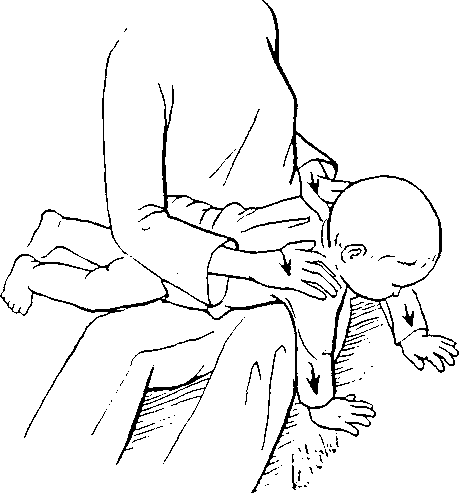
32 HOME INSTRUCTIONS
Head Approximation in Prone
Purpose
To aid child in holding head up while lying on stomach
instructions
1. Sit on the floor.
2. Place child on stomach, lying across your legs. Place child's hands on floorto help support body weight.
3. Place your hand over child's head as pictured below. Child's neck and back should be straight.
4. Firmly push on head and release. Repeat several times.
Undesired Response
Back or neck will become stiff; head will come up too far.
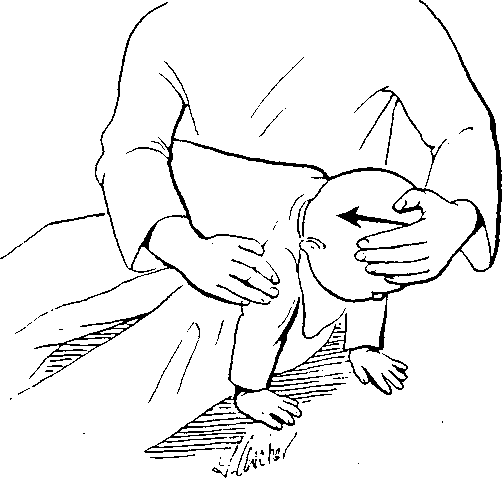
33 HOME INSTRUCTIONS
Arm Approximation Prone Over Roll
Purpose
To enable child to bear weight c.i arms and to strengthen neck and back muscles for better head control
Instructions
1. Place child on stomach, lying over a roll as pictured below.
2. Arris should be apart, not crossed.
3. Place your hand(s) over child's shoulder(s).
4. Firmly press downward and release. Repeat several times.
Desired Response
Child will be able to support own weight on hands with elbows straight, hands open, head erect.
Undesired Response
Back, neck, or arms will become stiff, hands will fist, or elbows and head will flop.

34 HOME INSTRUCTIONS
Reaching While Prone Over Roll
Purpose
To aid child in increasing strength in neck and back muscles; to enable child to bear weight on one
arm while reaching with the other
Instructions
1. Place child on stomach, lying over a roll.
2. Hold child's legs apart with knees rolled out and straight (see Figure 1).
3. Encourage child to reach out for toys with one hand while shifting weight to opposite side (see Figure 2).
Desired Response
Child will reach out while bearing weight on one arm.
Undesired Response
Back or legs will stiffen.

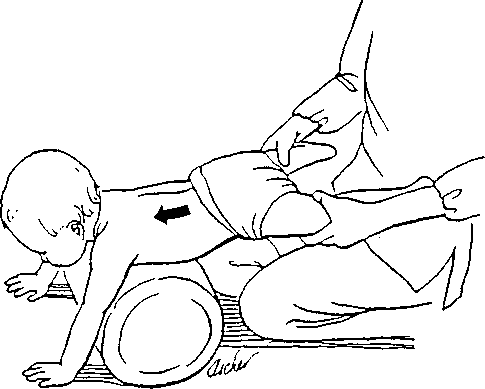
35 HOME INSTRUCTIONS
Arm Position for Head Extension
Purpose
To facilitate neck and back extension for better head control
Instructions
1. Place child on stomach, lyir.y over a roll.
2. Hold child's arms out to the side (see Figure 1).
3. Roll arms outward so that thumbs are pointed toward ceiling (see Figure 2).
Desired Response
Child will be able to hold head erect.
Undesired Response
Shoulder, back, neck, or arms will become stiff.


36 HOME INSTRUCTIONS
Prone on a Bail
Purpose
To develop ability to bear weight on arms
Instructions
1. Place child on stomach, lying on a ball as pictured. Be sure to hold legs apart with feet and knees turned out (see Figure 1).
2. Slowly roll the child forward (see Figure 2).
3. You may place a toy in front of the ball to encourage the child to reach down (see Figure 3).
Desired Responses
1. Child will place both hands on floor.
2. Child will reach for toy with one hand.
Undesired Response
Child's arms will become rigid or child will not reach with arms.

37 HOME INSTRUCTIONS
Neck and Back Extension with Hips Flexed
Purpose
To encourage neck and back straightening while hips and knees are bent
Instructions
1. Place the child on stomach with hips and knees bent; arms should not be trapped under chest.
2. Firmly press down on neck and back muscles as you slowly bring your hand from the neck toward hips.
3. Gentle tapping of the neck and back muscles may be beneficial prior to the firm pressure.
Desired Response
The child will lift and hold head up and straighten back.
Undesired Response
1. Child may straighten legs as head is lifted.
2. Shoulders and arms may pull back as the head is lifted.
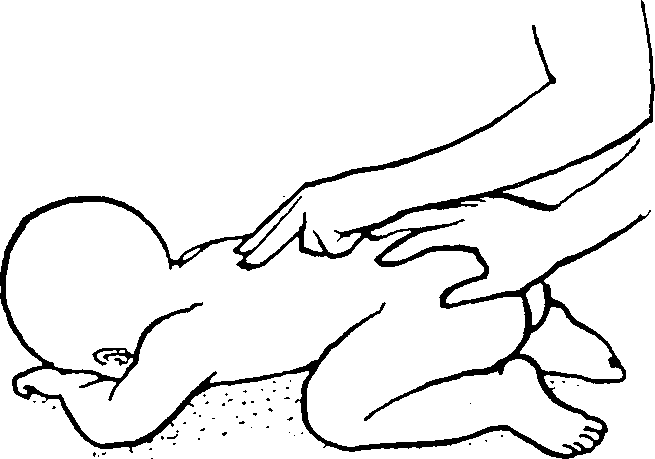
38 HOME INSTRUCTIONS
Playing Prone on Elbows
Purpose
To develop head and upper trunk control and ability to .bear weight on elbows
Instructions
1. Place child on stomach with a roll under the chest.
2. Provide toys to play with and to look at.
Desired Response
1. The child will hold head up, but continue to look down at the toys (tuck the chin).
2. Child will support self on elbows.
Undesired Response
1. Child will lift head too far and be unable to look down.
2. Child will pull shoulders up or back.
3. Head or arms will pull down.
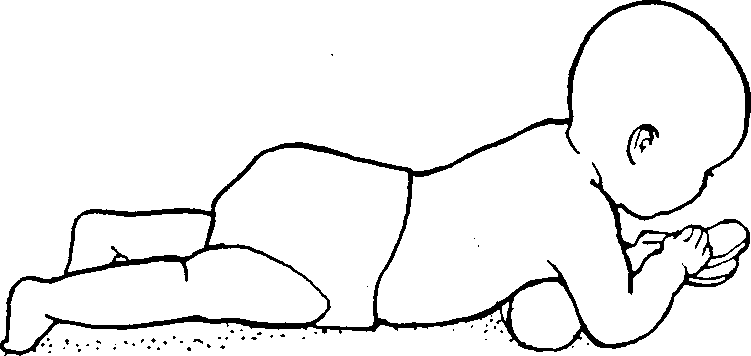
39 HOME INSTRUCTIONS
Tilting Sideways on Bail
Purpose
To encourage lateral trim movement and elongation on weight-bearing side
Instructions
1. Place child on stomach over ball.
2. Support at hips or lower trunk as needed (see Figure 1).
3. Slowly roll the ball sideways and wait for child to adjust (see Figures 2 and 3).
Desired Response
The child will move head and trunk in an upward direction so that you will see a curve in the trunk.
Undesired Response
1. The child will use hands for support instead of curving the trunk.
2. The head and trunk will arch back and the shoulder will retract.
3. The trunk will not adjust to the tilt.

40 HOME INSTRUCTIONS
Tilting Sideways on Roll
Purpose
To encourage protective reactions of arms
Instructions
1. Place child on stomach, lying parallel to the length of the roll.
2. Support the hips or lower trunk as needed (see Figure 1).
3. Slowly tilt the child and roll sideways (see Figure 2).
Desired Response
The child will support self with hand at the end of the movement.
Undesired Response
1. Child will become stiff.
2. Arms will bend rather than straighten.
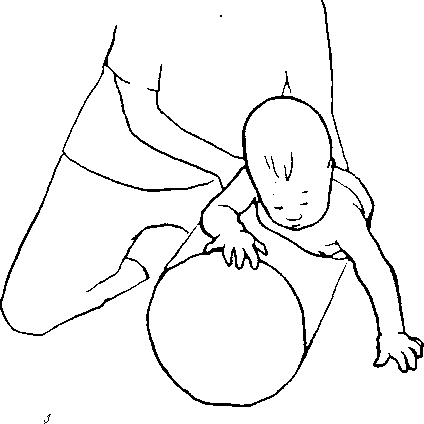

41 HOME INSTRUCTIONS
Shoulder Elevation
Purpose
To encourage shoulder elevation and outward rotation
Instructions
1. Place child on stomach on your legs (Figure 1).
2. As you play with the child, slowly shift your leg out to the side, so that your leg moves from under
the child's chest to under the arms. This will gradually allow more shoulder elevation by the child
(see Figure 2).
3. Support the child's shoulder forward ;."id help child turn thumbs up (see Figure 3).
Desired Response
Shoulder elevation will occur with outward rotation while head is up.
Undesired Response
1. Shoulders will pull down and back..
2. Thumbs will turn down.
3. Elbows will bend.
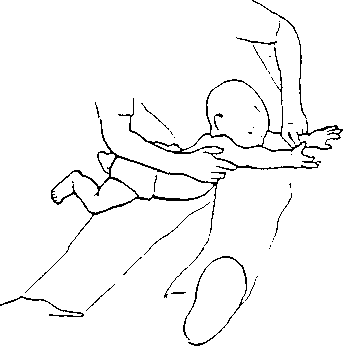
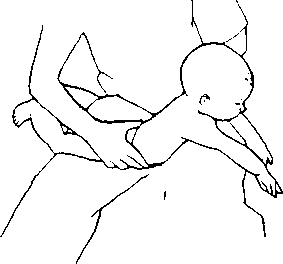
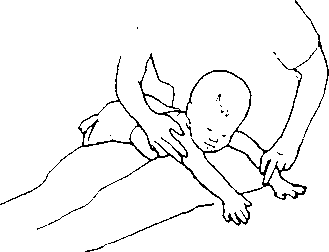
42 HOME INSTRUCTIONS
Play Over Legs
Purpose
1. To improve head and trunk control
2. To encourage child to bear weight on arms
Instructions
1. Place child on stomach over your legs.
2. Provide a toy for the child to play with.
Desired Response
1. Child will hold head up while looking at and playing with the toy.
2. Child will support body weight with hands.
Undesired Response
1. Child will arch the head and trunk back.
2. Child will pull the arms up with elbows bent.
3. Legs will pull together.
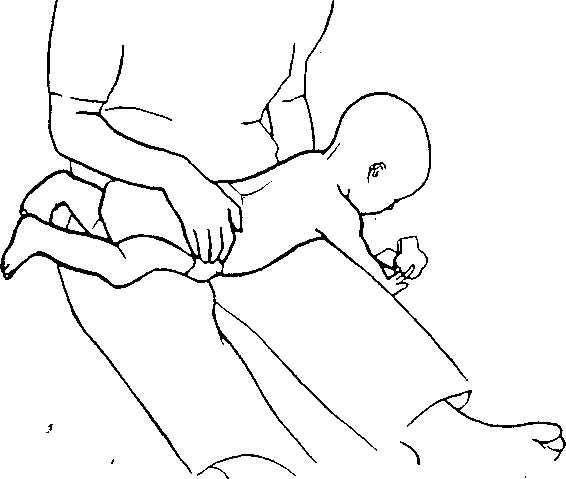
43 HOME INSTRUCTIONS
Dissociation of Legs and Heel Pressure
Purpose
To prepare child for standing and walking
Instructions
1. Place child, on stomach over your leg.
2. Bend one leg between your legs and keep one leg straight (see Figure 1).
3. Provide gentle intermittent pressure to the bottom of the heel of the straight leg .
Desired Response
The child will hold the leg straight without pushing down with the foot.
Undesired Response
1. The child will bend the leg.
2. The child will push down with the foot.
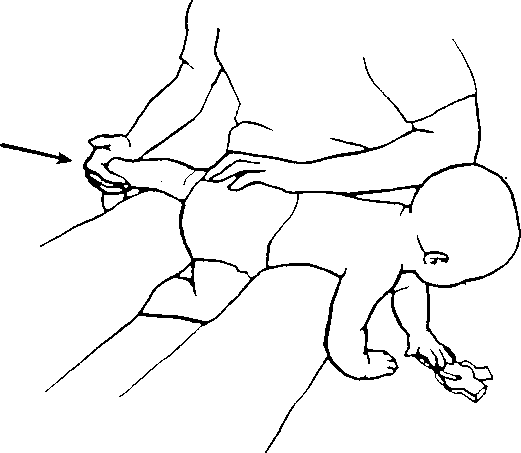
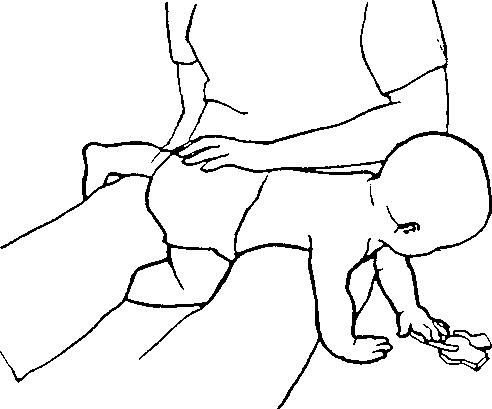
44 HOME INSTRUCTIONS
Dorsiflexion with Knee Extension (Sidelying)
Purpose
To help child learn to pull foot up while the knee is straight
Instructions
1. Place child on side, lying with upper knee straight. '
2. With firm pressure, rub the ankle from the forefoot to the foreleg. (This should be done on the big toe side of the ankle.)
3. Place a small toy in front of the child and have child reach for that toy while keeping the knee straight.
Desired Response
The foot will pull up either when you are rubbing or when child reaches for the toy.
Undesired Response
The child will pull away from you or bend the knee.
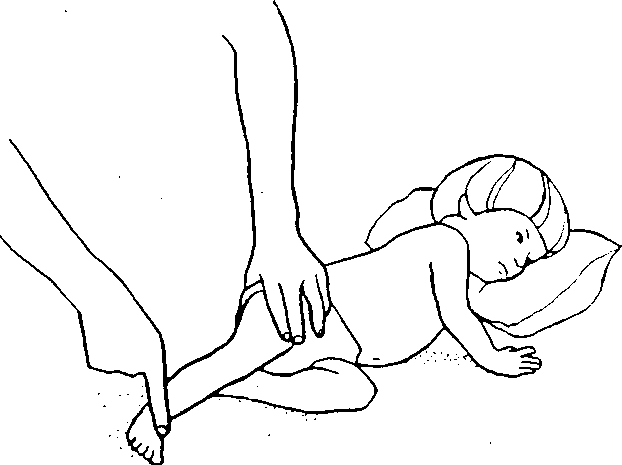
45 HOME INSTRUCTIONS
Weight-Bearing on Extended Arms
Purpose
To develop ability to stabilize with upper arm for weight-bearing and other activities
Instructions
1. Place child on stomach in front of you.
2. Spread child's legs apart on either side of your waist with the knees straight.
3. Assist child at shoulders to lift self up onto arms.
4. If child's trunk sags, gently rub child's stomach so muscles will straighten trunk.
5. If arms do not remain straight, gently tap back of arm just above the elbows so muscles will straighten elbows.
Desired Response
Child will maintain weight on straight arms with a straight trunk.
Undesired Response
The trunk will sag or arms will bend and not maintain child's weight.
